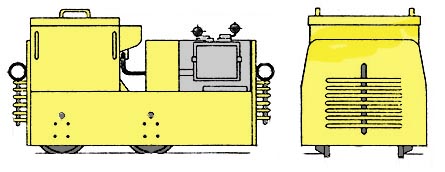| Silverdalen ("Silver-valley Papermill"), Småland |
| Manufacurer: | Aktiebolaget Gävle Vagnverkstad - AGV, Gävle, Sweden | |
| Manufactureing number: | 428 | |
| Manufactureing year: | 1970 | |
| Type: | Battery Locomotive AL-3 | |
| Locomotive weight, incl. battery: | 2 tons | |
| Length over buffer beams: | 1745 mm | |
| Width: | 950 mm | |
| Height: | 1100-1310 mm | |
| Track gauge: | 600 mm | |
| Wheel base: | 692 mm | |
| Wheel diameter: | 350 mm | |
| One-hour traction motor power: | 3 kW | |
| One-hour traction motor speed: | 1800 r/min | |
| Traction motor voltage, nominal: | 70 V | |
| Starting tractive effort: | 450 kp | |
| One-hour tractive effort: | 200 kp | |
| One-hour speed: | 4,7 km/h | |
| Max speed: | 8 km/h |
 The locomotive is driven by an electrical traction motor. The torque is transmitted to the wheel axles of the locomotive by means of diving gears, mounted directly on the wheel axles. Speed and traction effort control as well as reversing are effected by means of an electrical controller which connect and disconnect a starting resistor over contactors. The locomotive is braked by means of a hand level brake actuating the primary shaft of the rear driving gear or, in the case the locomotive is equipped with remote control, by means of a magnetic brake actuating the same axle and controlled with a foot contact. Locomotive frame and battery case are manufactured of steel sheet and are in welded construction. Locomotive battery of alkaline (NIFE) as well as lead acid type (SAAJ-Lorica) is available for this type of locomotive. |
| |
| REMARKS The Locomotive is named after its former owner by OKJ. |